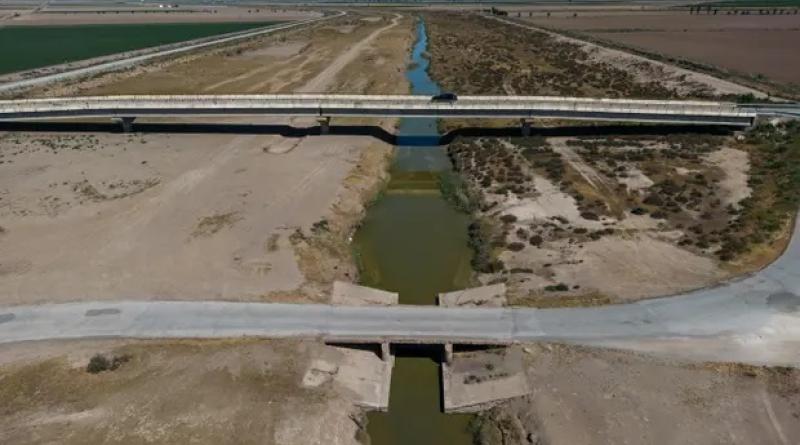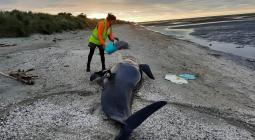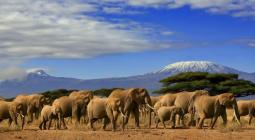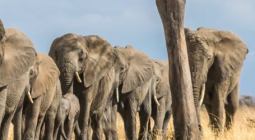Why elephants, otters and whales are nature’s secret weapons against climate breakdown

What do elephants, otters and whales have in common? They all increase the amount of carbon that can be stored in their ecosystems. Elephants disperse seeds and trample low vegetation, enabling taller trees to grow. Sea otters eat sea urchins, allowing kelp to flourish. Whales feed at depth and release nutrients as they breathe and rest at the surface, stimulating phytoplankton production.
It isn’t just these three. We are beginning to learn that many species have complex effects on their environments that change the amount of carbon stored by their surrounding ecosystems – ultimately affecting climate change. When the population of wildebeest in the Serengeti plummeted due to disease, they no longer grazed as much, and the uneaten grass caused more frequent and more intense fires. Bringing back the numbers of wildebeest through disease management has meant fewer and smaller fires. And the Serengeti has gone from releasing carbon back to storing it
.
These are examples contained in a stunning new paper just published in Nature. It makes the case that animals cause ecosystems to be more effective in storing carbon, through their eating, moving, trampling, digging, defecating and building. Looking across a range of different studies, it concludes that wild animals account for only 0.3% of the carbon in the total global biomass, but can cause anywhere between 15% and 250% difference in how much carbon is stored in a given ecosystem.
We already knew that so-called “nature-based solutions” need to be part of any effective strategy to tackle climate breakdown. Reducing emissions is not going to be enough – we need to use the immense power of nature to remove carbon from the atmosphere and lock it up. But this new research carries important lessons for how we pursue these nature-based solutions.
First, nature works. Specifically, the complex mechanisms that nature has developed are startlingly effective in ways we do not yet fully understand – and we destroy them at our peril. It may well be sensible to try to develop new technologies to capture carbon, but it is definitely not sensible to ignore the proven ways of doing so that nature already gives us. We would do well to be a little less enamoured of our own ingenuity, and a little more respectful of nature’s.
This means avoiding the urge to go for quick and simple fixes of plant monocultures to sequester carbon, devoid of animals. The current emphasis for nature-based solutions is on the plants – restoring mangroves, kelp and seagrasses, for example. They are important, but can only be part of the answer. The Nature paper uses the example of the Arctic, where huge amounts of carbon is stored in the permafrost. Ensuring there are herds of large animals will help keep the carbon there, by compacting the snow, keeping the soil frozen. Restoring populations of reindeer, wild horses, musk ox and American bison is not a nice-to-have tangential to the main effort against climate change, but a key part of that effort.
Second, conservation works. We know that nature can recover when given the chance, and that animal populations can bounce back quickly. We know how to do it – it needs habitats to be protected, interests to be aligned with local communities and the conditions recreated for animal populations to return at scale. We now have numerous examples of conservation’s success, from the return of red kites in England to the recovery of tigers across much of Nepal and India.
This work is the purpose of the organisation I lead, the Zoological Society of London (ZSL). When I took this job, a small part of me worried that working on wildlife was a bit of luxury, given the enormity of the threat from climate change. We know now that the opposite is true. Understanding the role that animals can play in helping nature capture carbon has profound implications for how we do conservation.
We are moving away from the arid old model of conservation through segregation – separating nature from people in order to allow it to flourish. That simply isn’t enough. Instead, our focus is on helping wildlife and people co-exist, by supporting efforts to reduce conflict between them and working with communities who are vital to the health of their wild animals. This has long been the approach that ZSL has taken to conservation, and we know it works.
It was this approach that saw local communities set up their own sanctuaries for pangolins on Palawan island in the Philippines, and it is this approach that is helping to identify conservation solutions for the protection of the critically endangered angel shark off the UK’s coastline. And it is just as true for cities as it is for the Serengeti – as our recent report explains, nature can help mitigate the impact of extreme weather in urban areas as well.
A world in which wildlife thrives is also a world that has the resilience it needs to withstand and mitigate the climate crisis. Our future is inextricably intertwined with the wellbeing of the world’s wild animals. If we want to save ourselves, we need to do better at protecting them.
cover photo:A giant sperm whale, whose breath can stimulate the production of carbon-storing phytoplankton. Photograph: uwimages/Getty/iStockphoto






